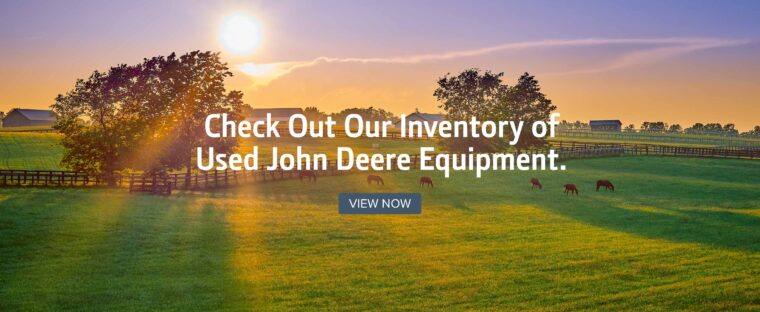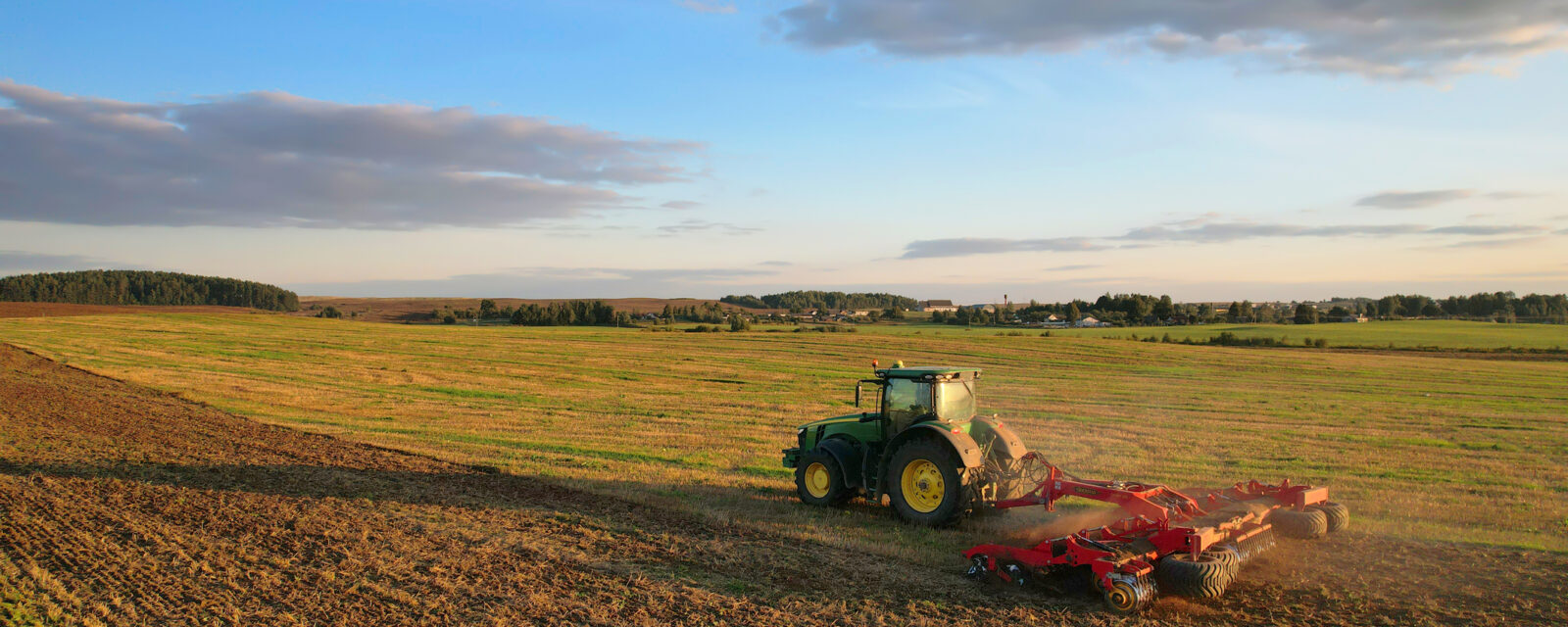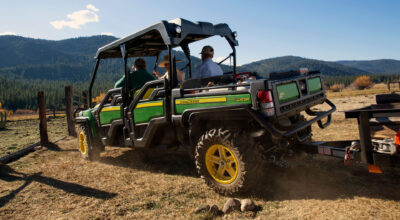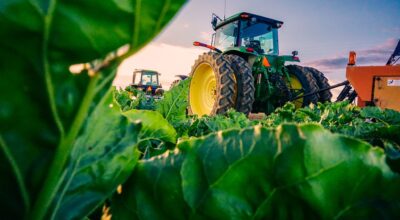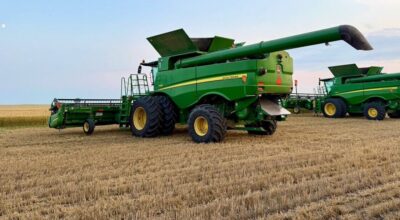It’s never too early to think about post-harvest preparation. Effective post-harvest field prep does more than tidy up — it protects your land, improves soil health, and extends the life of your equipment.
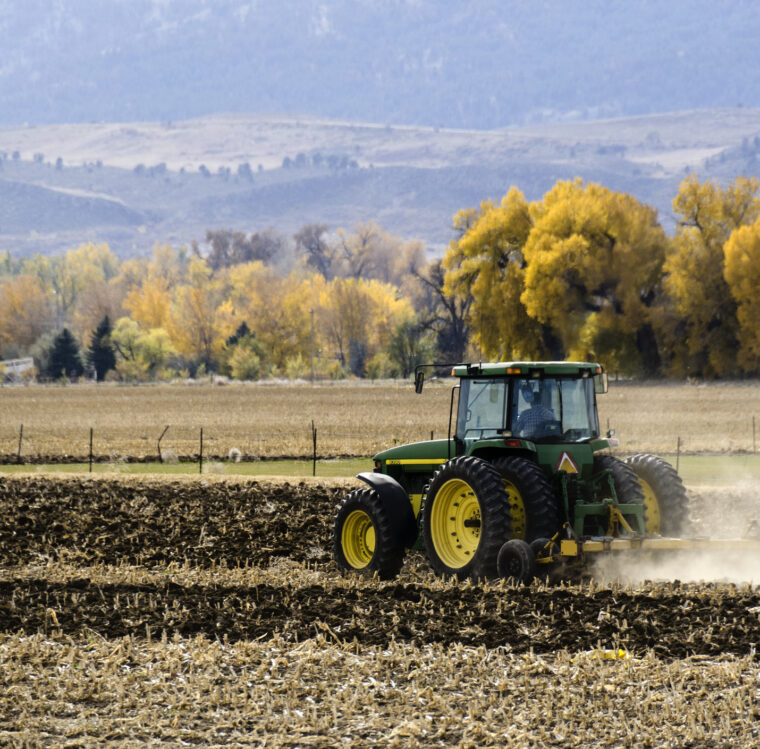
From managing residue to regrading driveways, John Deere tractors and implements are built to help you end the season right and start the next one even stronger.
Key Takeaways
- Fall is the best time for post-harvest field prep to improve soil health, manage residue, and reduce spring workload.
- Rotary cutters and flail mowers help break down corn stalks and soybean stubble for faster decomposition and better nutrient cycling.
- Box blades and scarifiers are essential for smoothing rutted driveways and repairing field edges after heavy harvest traffic.
- Pasture aeration and dragging restore compacted soil, enhance forage quality, and distribute nutrients evenly across livestock areas.
- Winterizing your tractor and attachments — from draining fuel to checking hydraulics — protects performance and prevents downtime in spring.
Top Fall Projects to Consider
Once harvest ends, what remains behind is just as important as the crops you hauled away. Corn stalks, husks, and other residue often blanket the field after harvest, attracting pests, locking up nutrients, and delaying soil warming in spring.
A rotary cutter mounted on your John Deere tractor makes quick work of tough material like corn stalks, slicing and shredding them into smaller, more manageable pieces. Accelerating residue breakdown promotes quicker decomposition, minimizing seedbed obstructions and nutrient tie-up come spring.
For lighter residue like soybean stubble, a flail mower may be a better fit. It produces a finer, more even chop, and distributes the plant material uniformly across the field. Balanced coverage supports consistent microbial activity and improves soil health, conserving moisture and reducing erosion during winter.
Driveway and Field Smoothing
Releveling Driveways and Field Edges
After a season of harvest traffic, gravel driveways and field borders are often left with ruts, washouts, and compacted ground. In addition to being inconvenient, these problems can accelerate tire wear and hinder safe movement to barns or fields.
Scarifiers help loosen tightly packed areas so the box blade can do a more effective job. They’re especially useful for breaking through worn field edges, making it easier to move and redistribute material evenly when grading.
A box blade’s rear-facing cutting edge reduces high spots and draws material into low ones, creating a smoother surface with each pass. The result is better drainage and a safer, more stable route for hauling loads.
Clearing Fence Lines and Tree Lines
Overgrown fence lines and tree rows can become serious hazards when winter weather rolls in. Ice buildup and wind can bring down dead branches onto fences, livestock enclosures, or parked equipment, and thick brush can block access altogether.
A rotary cutter is the ideal choice for clearing overgrowth along fence lines and knocking down tall weeds and vines that can hide damage. Keeping boundary zones clear from creeping vegetation helps prevent issues like weakened posts and bent wire.
Tree lines near barns, driveways, and field edges deserve the same attention. Trimming back weak or low-hanging limbs with a limb saw or pole pruner improves visibility and opens equipment paths while reducing the risk of branch breakage from snow and ice.
Pasture Dragging and Aeration
Even if a pasture appears green after summer, surface-level growth can hide soil that’s tired, compacted, or overloaded with waste. Fall is your best opportunity to reset your soil and boost your field’s forage quality before winter sets in.
One of the most common issues lurking beneath the surface is compaction. If your pasture feels hard underfoot or regrowth is patchy, it’s likely due to repeated pressure from livestock or equipment pressing the soil too tightly. This restricts airflow and water movement, making it harder for forage to recover and grow.
Begin by dragging to break up manure clumps and distribute them evenly across the field. Dragging redistributes nutrients and disrupts environments where parasites like worms and larvae thrive, especially in high-traffic livestock areas like feeders or shade zones.
Additionally, running a spike aerator relieves compaction by creating holes that allow oxygen and moisture to reach the root zone. Pairing aeration with overseeding, particularly with cool-season grasses, can quickly fill in weak spots and set the stage for thicker, healthier growth next spring.
Pre-Winter Tractor and Implement Maintenance
Before winter arrives, inspect your equipment carefully to avoid damage and protect performance. Prioritize the following tasks to keep your machines in top shape during the off-season.
- Drain or stabilize fuel lines: Diesel left sitting all winter can attract moisture, leading to condensation, microbial growth, or gelling in the tank. Use a fuel stabilizer or fully drain the system to avoid clogged filters or a no-start situation when temperatures drop.
- Inspect tires for wear and top off pressure: Cold air decreases tire pressure, which can lead to flat spots or cracking during storage. Check for visible signs of wear or dry rot, then inflate to the recommended PSI to keep sidewalls protected and ready to roll.
- Grease all fittings and check hydraulics: Apply fresh grease to all lubrication points, especially around joints and pivot pins, to keep parts moving smoothly and shielded from winter wear. While you’re at it, check hydraulic hoses for cracks, soft spots, or leaks since cold temperatures can worsen existing damage.
- Store attachments in a covered space: Keep implements in a barn, shed, or under a heavy-duty tarp to protect them from UV rays and moisture. Prolonged exposure to the elements wears down rubber, fades paint, and causes metal parts to deteriorate. Giving attachments a quick brush-off before storage also helps prevent rust and corrosion from setting in.
Attachments That Add Value This Season
The right attachment can make post-harvest field prep quicker, cleaner, and easier to manage. With that in mind, there are several attachments worth considering before winter.
- Box blades: Ideal for smoothing out gravel driveways or reshaping uneven field edges, a box blade cuts high spots and redistributes material in one pass. Many models come with adjustable scarifiers to break through compacted ground — perfect for post-harvest ruts or washouts.
- Rotary cutters: Whether you’re tackling tall grass or crop residue, rotary cutters are built to cut through dense growth. By chopping and dispersing material evenly, rotary cutters speed up decomposition and leave fields cleaner for spring prep.
- Post-hole diggers: A three-point hitch post-hole digger drills clean, uniform holes for fence posts, gate anchors, or tree planting — no shovel required. It’s a major time-saver when working through compacted or clay-heavy soil, especially before the ground freezes.
- Landscape rakes: Great for clearing leaves, sticks, and leftover debris from pastures or driveways, landscape rakes help tidy up before winter hits. They can also be used to spread topsoil or gravel evenly, leaving a clean finish behind.
Looking to expand your lineup before winter? John Deere’s MachineFinder is a great place to find high-quality, gently used attachments all backed by trusted dealers. It’s a cost-effective way to add the tools you need without the price tag of buying brand new.
Looking Ahead
Fall might mark the end of harvest, but it’s also an ideal time to get ahead of the game. Proactive post-harvest field prep can lighten your spring workload, protect your equipment, and help you avoid costly repairs in the future.
Don’t wait for winter to uncover problems that fall prep could’ve prevented. Get ahead this season by browsing fall-ready tractors and attachments or talk to your local John Deere dealer about year-end financing and equipment bundles.
